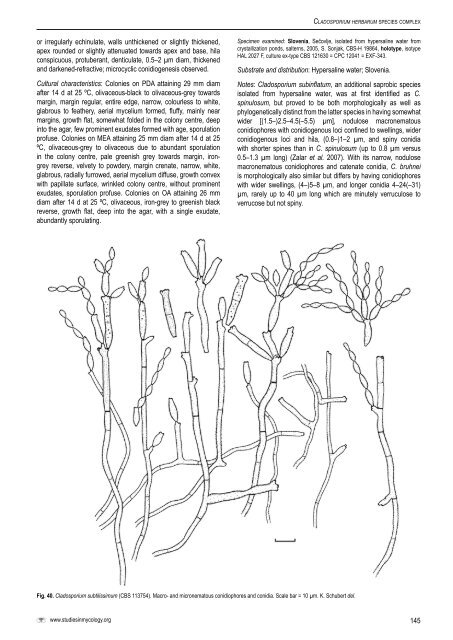The genus Cladosporium and similar dematiaceous ... - CBS - KNAW
The genus Cladosporium and similar dematiaceous ... - CBS - KNAW
The genus Cladosporium and similar dematiaceous ... - CBS - KNAW
You also want an ePaper? Increase the reach of your titles
YUMPU automatically turns print PDFs into web optimized ePapers that Google loves.
<strong>Cladosporium</strong> herbarum species complex<br />
or irregularly echinulate, walls unthickened or slightly thickened,<br />
apex rounded or slightly attenuated towards apex <strong>and</strong> base, hila<br />
conspicuous, protuberant, denticulate, 0.5–2 µm diam, thickened<br />
<strong>and</strong> darkened-refractive; microcyclic conidiogenesis observed.<br />
Cultural characteristics: Colonies on PDA attaining 29 mm diam<br />
after 14 d at 25 ºC, olivaceous-black to olivaceous-grey towards<br />
margin, margin regular, entire edge, narrow, colourless to white,<br />
glabrous to feathery, aerial mycelium formed, fluffy, mainly near<br />
margins, growth flat, somewhat folded in the colony centre, deep<br />
into the agar, few prominent exudates formed with age, sporulation<br />
profuse. Colonies on MEA attaining 25 mm diam after 14 d at 25<br />
ºC, olivaceous-grey to olivaceous due to abundant sporulation<br />
in the colony centre, pale greenish grey towards margin, irongrey<br />
reverse, velvety to powdery, margin crenate, narrow, white,<br />
glabrous, radially furrowed, aerial mycelium diffuse, growth convex<br />
with papillate surface, wrinkled colony centre, without prominent<br />
exudates, sporulation profuse. Colonies on OA attaining 26 mm<br />
diam after 14 d at 25 ºC, olivaceous, iron-grey to greenish black<br />
reverse, growth flat, deep into the agar, with a single exudate,<br />
abundantly sporulating.<br />
Specimen examined: Slovenia, Sečovlje, isolated from hypersaline water from<br />
crystallization ponds, salterns, 2005, S. Sonjak, <strong>CBS</strong>-H 19864, holotype, isotype<br />
HAL 2027 F, culture ex-type <strong>CBS</strong> 121630 = CPC 12041 = EXF-343.<br />
Substrate <strong>and</strong> distribution: Hypersaline water; Slovenia.<br />
Notes: <strong>Cladosporium</strong> subinflatum, an additional saprobic species<br />
isolated from hypersaline water, was at first identified as C.<br />
spinulosum, but proved to be both morphologically as well as<br />
phylogenetically distinct from the latter species in having somewhat<br />
wider [(1.5–)2.5–4.5(–5.5) µm], nodulose macronematous<br />
conidiophores with conidiogenous loci confined to swellings, wider<br />
conidiogenous loci <strong>and</strong> hila, (0.8–)1–2 µm, <strong>and</strong> spiny conidia<br />
with shorter spines than in C. spinulosum (up to 0.8 µm versus<br />
0.5–1.3 µm long) (Zalar et al. 2007). With its narrow, nodulose<br />
macronematous conidiophores <strong>and</strong> catenate conidia, C. bruhnei<br />
is morphologically also <strong>similar</strong> but differs by having conidiophores<br />
with wider swellings, (4–)5–8 µm, <strong>and</strong> longer conidia 4–24(–31)<br />
µm, rarely up to 40 µm long which are minutely verruculose to<br />
verrucose but not spiny.<br />
Fig. 40. <strong>Cladosporium</strong> subtilissimum (<strong>CBS</strong> 113754). Macro- <strong>and</strong> micronematous conidiophores <strong>and</strong> conidia. Scale bar = 10 µm. K. Schubert del.<br />
www.studiesinmycology.org<br />
145

















